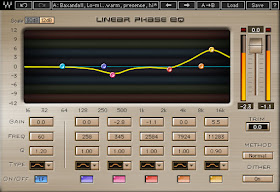EMMY award winning composer Jason Hausman is a renaissance man of sorts. His design company, Hot Sake, scores films and trailers, creates sounds for video games, music for commercials, children's toys, art installations and more. Hausman is known for his inventive take on the creation of sound; he plays pine-cones, records the sounds of falling water and coaxes creative noise from metal mixing bowls as he composes music in his Charlotte NC studio.
Hausman is also a wicked guitarist, singer and songwriter, and is always at the forefront of innovative music projects. In keeping with his penchant for all things cool, he is also a Master falconer. We mentioned the renaissance man thing, right?
Hausman is an astute collector of guitars. As a craftsman himself, he has a keen eye for workmanship and attention to detail in the work of others. Recently, Hausman enlisted the expertise of luthier Jack Coobs to create a custom six string work of art especially tailored for him.
“I had been admiring Coobs guitars for several years,” admits Hausman.
“I had strummed a couple briefly and could feel the resonance throughout the instrument, and they were, of course, stunning! After meeting Jack a few times and talking music, he handed me one of his acoustics to take it for a spin. It was a fantastic instrument. The tone, resonance, and attention to detail was some of best I had come across.”
A few months later, Hot Sake hosted an Aly Tadros concert and Hausman invited Jack.
“We really started discussing the possibilities of building me a guitar. A few days after the show, Jack asked me if I would be interested in collaborating on a signature model. He did not have to ask twice. I knew I liked him, liked his family, liked his work and felt that he could help me get what I was looking for in a new acoustic,” says Hausman.
“I asked Jack if he could make something light and open sounding like my 110. When he saw it, I think he might have thought I was crazy, or Hell, maybe it was just an insult!” laughs Hausman. “But he took it on. It is a small-bodied guitar, so being a falconer, I decided to dub it The Tiercel, which is the term for the male Peregrine Falcon. My friend, Ben Gibson, a fellow falconer and incredible artist created the artwork for the peregrine feather that adorns the headstock in abalone.”
Jack decided he wanted to make a mahogany one to adhere to the tone woods of Hausman's old favorite, and also a Koa version. Hausman says, “Jack was great about staying true to what I wanted. The only major deviation was on my request. I wanted a slotted headstock. I also asked for L.R. Baggs pickup, Waverly open tuners and the old style pyramid bridge.”
When Jack finished the guitars, he and Hausman decided to meet at Ben Premeaux’s studio smARTlab so the guitars could be photographed. “When Jack brought them in, he sat the cases down and we talked for awhile. He finally looked at me and said, 'Well, are you going to get one out or not, dude?! What the Hell?'” remembers Hausman.
“Laughing out loud, I admitted that I was terrified to play one. I was so locked into the sound of my old favorite that I was afraid that after all this collaboration and work that I would end up hating them! I knew they would be beautiful, and I knew they would sound great! But what I did not now is if they would have that special mojo from the get go.” says Hausman.
“Once I began to play them, I could not stop grinning,” recalls Hausman. “They were similar in a way, in that they both had that thing! While the mahogany one was certainly more true to the original, the koa model had a certain sharpness in the detail, a punch that would lend itself to finger picking. They were both, so open, so resonant. They just seemed to come alive instantly. Like they were waiting to be played. Everyone that has played them has said the same thing. They just evoke that subtle shake of the head and a quiet “wow…” from everyone that sits down with them.”
Hausman's mom's inspirational 110 still hangs on the wall of his studio. “I think she might be jealous,” he admits. “Since I got my Coobs Guitars, I just haven't been able to put them down and pick up anything else!”
Moonstruck Promotions
Become fan of this blog on Facebook! Share it and contact us to collaborate!!








